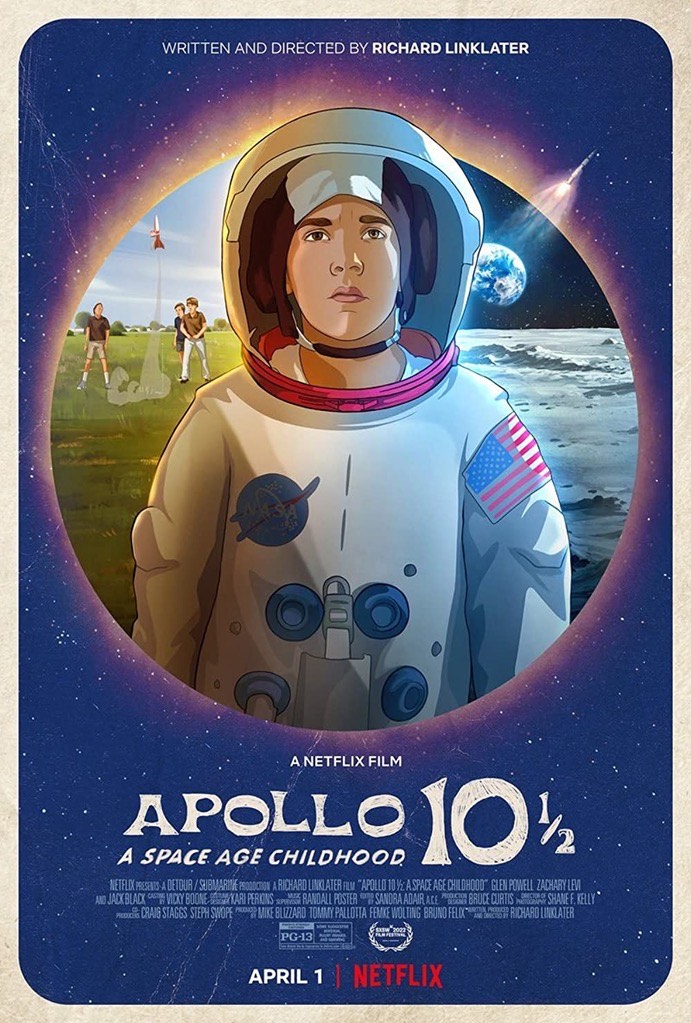
Have you ever dreamed of being an astronaut? If so, then Netflix’s newest film, “Apollo 10½: A Space Age Childhood,” is perfect for you. The film follows a 10-year-old boy named Stanley who desperately wants to become an astronaut and walk on the moon. Half space fantasy, half nostalgia trip down memory lane, “Apollo 10½: A Space Age Childhood” explores growing up in the 1960s. The majority of the film is animated in a rotoscope style, in which parts of the film are shot in live-action first and then animated, giving the animation a realistic and grounded feel.
It is no secret that Netflix original films have a bad reputation, as they are known for being schlocky and lazily produced features. However, in recent years, Netflix has started to turn a new page by hiring skilled directors to make their films. For instance, in 2019 Netflix released two of their most popular films, “The Irishman” and “El Camino: A Breaking Bad Movie,” which were directed by Martin Scorsese and Vince Gilligan, respectively. At the 94th Academy Awards this past March, Netflix was able to pick up a best picture nomination and best director win for its original film “The Power of the Dog,” directed by Jane Campion.
“Apollo 10½: A Space Age Childhood” continues Netflix’s upward trend as the film is directed by Academy Award nominee Richard Linklater. Linklater is an acclaimed indie director, having directed films like the “Before” romance trilogy, “Boyhood” and even “School of Rock.” Linklater’s films have a distinct vibe, as the theme of coming of age in the suburbs from “Boyhood” and the animation style from his other rotoscope animation films like “Waking Life” are further explored in “Apollo 10½: A Space Age Childhood.”
On the whole, “Apollo 10½: A Space Age Childhood” is a well-crafted and enjoyable film that can be appreciated by adults and children alike but definitely skews older, especially to audiences who grew up in the 1960s. Although many films are about growing up and maturing, “Apollo 10½: A Space Age Childhood” takes an inventive approach by making Stanley an unreliable narrator. The audience follows along as he describes his role in the Apollo missions, questioning how much he embellishes. Stanley embodies the idea of childlike imagination as he details how he was actually the first person to walk on the moon. The audience is never really sure if he is telling the truth, which is the beauty of cinema, as anything has the potential to be possible in the diegetic world of each film.
Similarly, the animation style of the film works to confuse the audience about the reality of its story. Although Linklater has experimented with rotoscope animation before, “Apollo 10½: A Space Age Childhood” utilizes the animation style to both impress its audience and further its thematic content. The animation feels as though it is somewhere in between traditional animation and live-action cinema, capturing the blurred line between fantasy and reality that goes along with Stanley’s narration. The animation is also incredibly visually appealing to look at and gives the film a unique feel that will stay with the audience long after viewing. Rotoscope animation has the advantage of allowing actors’ performances to shine, and there is one particular scene where you can see a character’s eyes change as he learns new information, a subtle detail that shows the benefit of rotoscope animation.
“Apollo 10½: A Space Age Childhood” also experiments with its method of storytelling, as the film is told entirely through flashbacks narrated by an older Stanley. Furthermore, these flashbacks are not always placed in chronological order, teasing the audience about what is to come later in the narrative. The beginning of the film sets up the idea of Stanley working at NASA and then the film cuts back to earlier in his life, providing the audience with some important questions that will be answered later. Later in the film, there is crosscutting between Stanley as an astronaut and his daily life while the Apollo 11 mission was going on, giving the impression that by day he is a normal kid, but by night he dreams or imagines being an astronaut. The juxtaposition of these shots going back and forth perfectly encapsulates the imagination of a child.
Another reason that “Apollo 10½: A Space Age Childhood” is so compelling as a film is that it feels almost autobiographical in nature, with Stanley serving as a surrogate for Linklater himself. Stanley describes the food, films, music, board games and television of the era, making the film a perfect time capsule of the space age. However, the film also explores some of the problems of the era too, including nuclear paranoia, child abuse, sexism and racism. Although the film mostly looks back at the 1960s with rose-colored glasses, it manages to address the important issues of the time too.
The only real problem with “Apollo 10½: A Space Age Childhood” is that it can get a bit distracted at points, with the narrative shifting too far away from the main plot of the film. While this may leave the audience feeling bored at points, the lack of focus also serves to give off the feeling of nostalgia as an old man recounts his favorite childhood memories. “Apollo 10½: A Space Age Childhood” is a hard film to criticize because it was clearly made with love and passion, something that can be seen in a lot of Linklater films and makes him one of the best directors working today.
“Apollo 10½: A Space Age Childhood” is an excellent film that has rich thematic content, a cool animation style and a nonlinear narrative that all work together to create a masterful work of art. Although it might not be as exciting as the newest superhero film or action blockbuster, “Apollo 10½: A Space Age Childhood” is worth your time because it expertly epitomizes the feeling of childhood nostalgia.
Rating: 4.5 out of 5 stars


